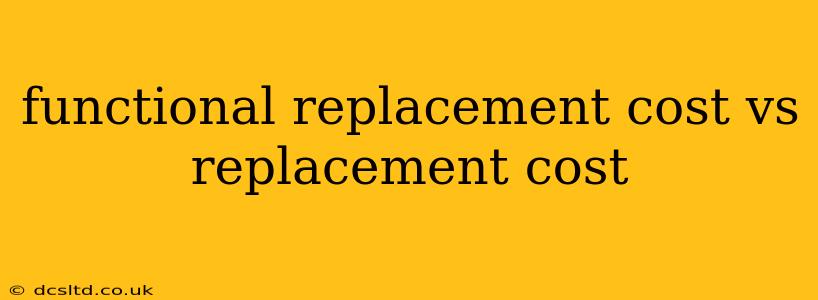Determining the value of an asset, whether it's a building, equipment, or even intellectual property, is crucial for insurance purposes, accounting practices, and financial planning. Two key concepts often arise in these evaluations: replacement cost and functional replacement cost. While both relate to the cost of replacing an asset, they differ significantly in their approach and resulting values. This article will delve into the nuances of each, clarifying their definitions and highlighting their practical applications.
What is Replacement Cost?
Replacement cost refers to the current cost of replacing an asset with a new one of like kind and quality. This means acquiring a functionally equivalent asset with similar features, specifications, and capabilities. It doesn't necessarily consider advancements in technology or design since the focus is on replicating the original asset as closely as possible. For example, the replacement cost of a 1950s house would be the cost of building a new house with the same square footage, materials (or equivalent modern substitutes), and architectural style.
Key Characteristics of Replacement Cost:
- Focus on exact replication: The goal is to rebuild or replace the asset identically, disregarding potential improvements.
- Current market prices: It reflects the current market prices for materials, labor, and construction.
- Higher cost: Generally, replacement cost will be higher than other valuation methods due to its emphasis on identical reconstruction.
What is Functional Replacement Cost?
Functional replacement cost, on the other hand, considers the cost of replacing an asset with a new one that provides the same functionality but may not be identical in terms of design, features, or specifications. This approach acknowledges technological advancements and improvements that can offer equivalent functionality at a potentially lower cost. Continuing the house example, the functional replacement cost would be the cost of constructing a new house with the same living space and utility but incorporating modern building materials, energy-efficient systems, and updated design elements.
Key Characteristics of Functional Replacement Cost:
- Focus on equivalent functionality: The emphasis is on replicating the asset's function, not its exact form.
- Modern materials and technology: It takes advantage of current technology and construction techniques.
- Lower cost (typically): It usually results in a lower valuation compared to replacement cost, as it leverages more efficient methods and materials.
Which Method Should You Use?
The choice between replacement cost and functional replacement cost depends on the context and the purpose of the valuation.
- Insurance purposes: Replacement cost is often preferred for insurance claims, as it aims to fully cover the cost of rebuilding or replacing the asset to its pre-loss condition. However, some insurance policies might factor in depreciation to arrive at a final settlement.
- Accounting and tax purposes: Functional replacement cost might be more appropriate for accounting and tax purposes, especially for depreciation calculations. This is because it reflects the current market value more accurately, considering advancements and potential cost savings.
- Financial planning: Both methods might be relevant in financial planning depending on the specific goal.
What are the factors influencing replacement and functional replacement costs?
Several factors influence both replacement and functional replacement costs. These include:
- Location: Land prices and construction costs vary significantly depending on location.
- Materials: The price of building materials fluctuates with market conditions.
- Labor costs: Skilled labor is a major expense in construction and can significantly influence costs.
- Design and specifications: Complex designs and high-end specifications increase the cost of construction.
- Technological advancements: Utilizing advanced technology can reduce costs but initially may involve a higher upfront investment.
How do I calculate replacement cost and functional replacement cost?
Calculating these costs accurately requires professional expertise. While simple estimations can be made based on market data and available resources, professional appraisers often employ sophisticated methodologies to take into account several factors.
In conclusion, understanding the difference between replacement cost and functional replacement cost is crucial for accurate asset valuation. Choosing the appropriate method depends heavily on the context and intended use of the valuation. Consulting with a qualified professional is recommended for complex situations to ensure an accurate and reliable assessment.
